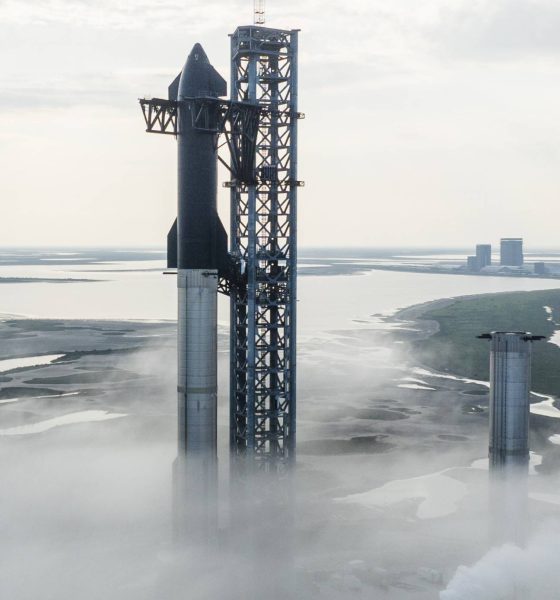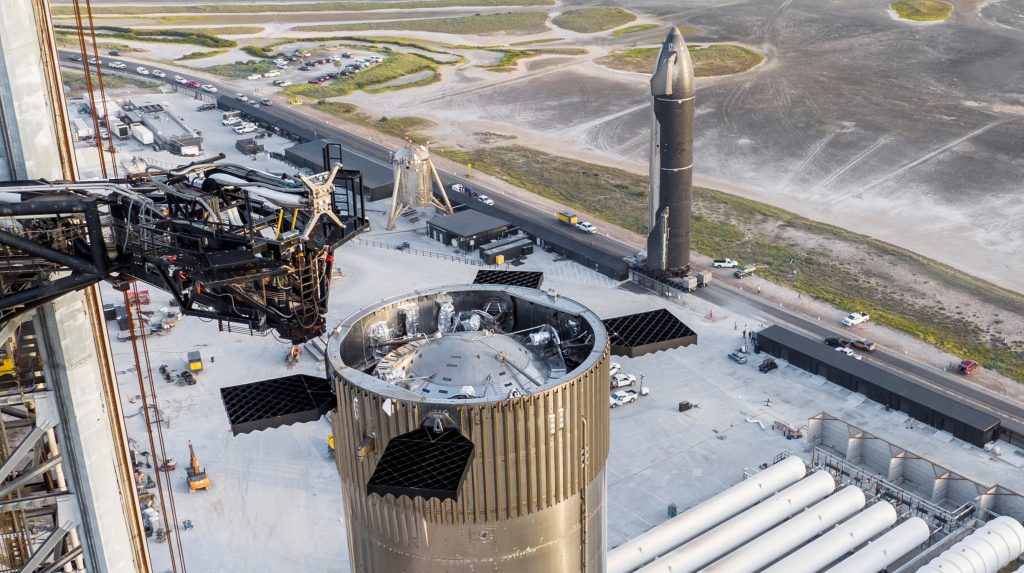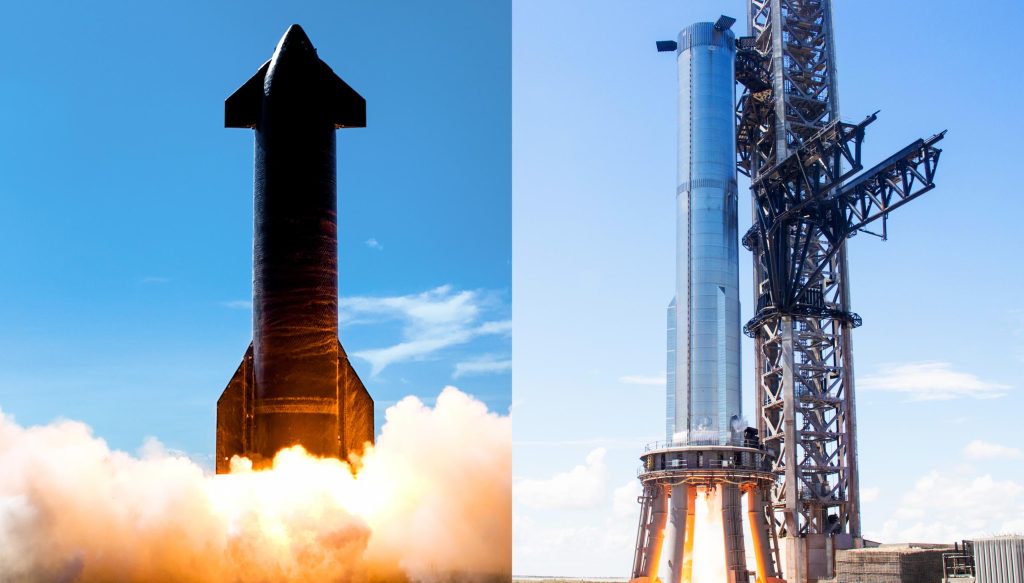

News
SpaceX Starship factory aiming to build five megarockets in 2023
CEO Elon Musk says that SpaceX’s South Texas Starship aims to build up to five of the two-stage megarockets in 2023.
SpaceX’s Boca Chica, Texas hardware endeavors began in an empty field in late 2018, kicking off Starhopper testing in 2019. In late 2019 and early 2020, the company began building the bones of the factory that exists today, relying heavily on several giant tents (“sprung structures”) similar to those used by Tesla. SpaceX has already begun the process of replacing those tents with larger, permanent buildings, but two of the original tents continue to host crucial parts of the Starship manufacturing process.
In terms of useful output, that manufacturing slowed down a bit in 2022. That slowdown can likely be partially explained by the need to move equipment and processes into the first finished section of Starfactory. But in general, SpaceX was simply focused on finishing and testing Starship S24 and Super Heavy B7 – both stages of the latest vehicle meant to attempt Starship’s first orbital launch.
Only by late 2022 did Ship 24 more or less complete proof testing, and Booster 7 is still several major tests away from solidifying full confidence in its design. SpaceX has only conducted limited testing with fully-stacked Starships, further reducing the amount of confidence the company can have in the assembled rocket. Lacking the data needed to know with certainty whether the tweaked designs of Starship and Super Heavy are good enough for several orbital test flights, it’s thus unsurprising that SpaceX only produced a handful of usable ships and boosters in 2022.

The update that's rolling out to the fleet makes full use of the front and rear steering travel to minimize turning circle. In this case a reduction of 1.6 feet just over the air— Wes (@wmorrill3) April 16, 2024
But if CEO Elon Musk’s forecast is correct, the company has plans to increase Starbase’s useful output in 2023. According to Musk, SpaceX aims to build “about five full stacks” this year, translating to five flightworthy Starships and five Super Heavy boosters.
In 2022, SpaceX finished Booster 7 and built Booster 8, Booster 9, and most of Booster 10. Booster 8 was almost immediately relegated to the retirement yard. Booster 9, featuring some significant design changes, completed a limited amount of proof testing and returned to the factory in early January – likely for Raptor engine installation. The fate of Booster 10 is unclear, but it stands as a prime example of how fast SpaceX can actually build massive Starship hardware when conditions are right. SpaceX began stacking B10 in late October 2022 and the vehicle is just two stacks away from full height three months later.
In the same period, SpaceX finished and immediately retired Starship S22, finished and began testing Ship 24, finished and began testing Ship 25, and finished stacking Ship 26. Booster 9’s upgrades partially insulate it from the most disappointing possible scenario, retirement before flight. Even if Booster 7 fails during prelaunch testing or its launch attempt, revealing major design flaws, it’s possible that Booster 9’s changes have already addressed those weaknesses, allowing it to continue the flight test campaign. Ship 25’s fate is even more dependent on the fate of Ship 24.
In 2022, SpaceX ultimately produced two “full stacks,” with a third (S26/B10) likely to be completed – albeit with a less certain fate – in early 2023. Delivering five full stacks this year – meaning five ships and five boosters that make it far enough to be paired with another and fully stacked – would be a major improvement. However, as was the case in 2022, higher-volume production will remain a risky proposition until the designs of the vehicles being built have been fully qualified.
Given how long it’s taken SpaceX to partially qualify Super Heavy Booster 7, it appears that the largest source of uncertainty will remain for at least another month or two, if not well into mid-2023. Starship production has many uncertainties of its own, and all of them are complicated by not knowing if a Super Heavy booster will be available to launch each new ship in a timely fashion.

Ultimately, an entirely different constraint means that “five full stacks” may be all SpaceX needs to build for the next 12+ months. After a long and painful process, the FAA completed an environmental review of SpaceX’s Starbase, Texas facilities, permitting a maximum of five orbital (full-stack) Starship launches per year. Starship’s FAA orbital launch license, which has yet to be granted, could be even more restrictive. A second Starship pad under construction in Florida is unlikely to be cleared for orbital launches until Starship has proven itself to be moderately safe in South Texas, which could easily take 12-18 months, if not longer.
Combined with the fact that no super-heavy-lift rocket in history has flown five times in its first year of launch activity, a trend Starship seems unlikely to break, SpaceX could practically halt production entirely in 2023 and still have a full year of testing ahead of it while only using Ships 24-26 and Boosters 7, 9, and 10. Unintuitively, that bodes well for a busy 2023 of Starship test flights, as much of the hardware required for three flight tests is already close to completion or almost ready to begin preflight testing.

News
Tesla FSD v14.2.2 is getting rave reviews from drivers
So far, early testers have reported buttery-smooth drives with confident performance, even at night or on twisty roads.

Tesla Full Self-Driving (Supervised) v14.2.2 is receiving positive reviews from owners, with several drivers praising the build’s lack of hesitation during lane changes and its smoother decision-making, among others.
The update, which started rolling out on Monday, also adds features like dynamic arrival pin adjustment. So far, early testers have reported buttery-smooth drives with confident performance, even at night or on twisty roads.
Owners highlight major improvements
Longtime Tesla owner and FSD user @BLKMDL3 shared a detailed 10-hour impression of FSD v14.2.2, noting that the system exhibited “zero lane change hesitation” and “extremely refined” lane choices. He praised Mad Max mode’s performance, stellar parking in locations including ticket dispensers, and impressive canyon runs even in dark conditions.
Fellow FSD user Dan Burkland reported an hour of FSD v14.2.2’s nighttime driving with “zero hesitations” and “buttery smooth” confidence reminiscent of Robotaxi rides in areas such as Austin, Texas. Veteran FSD user Whole Mars Catalog also demonstrated voice navigation via Grok, while Tesla owner Devin Olsen completed a nearly two-hour drive with FSD v14.2.2 in heavy traffic and rain with strong performance.
Closer to unsupervised
FSD has been receiving rave reviews, even from Tesla’s competitors. Xpeng CEO He Xiaopeng, for one, offered fresh praise for FSD v14.2 after visiting Silicon Valley. Following extended test drives of Tesla vehicles running the latest FSD software, He stated that the system has made major strides, reinforcing his view that Tesla’s approach to autonomy is indeed the proper path towards autonomy.
According to He, Tesla’s FSD has evolved from a smooth Level 2 advanced driver assistance system into what he described as a “near-Level 4” experience in terms of capabilities. While acknowledging that areas of improvement are still present, the Xpeng CEO stated that FSD’s current iteration significantly surpasses last year’s capabilities. He also reiterated his belief that Tesla’s strategy of using the same autonomous software and hardware architecture across private vehicles and robotaxis is the right long-term approach, as it would allow users to bypass intermediate autonomy stages and move closer to Level 4 functionality.
News
Elon Musk’s Grok AI to be used in U.S. War Department’s bespoke AI platform
The partnership aims to provide advanced capabilities to 3 million military and civilian personnel.

The U.S. Department of War announced Monday an agreement with Elon Musk’s xAI to embed the company’s frontier artificial intelligence systems, powered by the Grok family of models, into the department’s bespoke AI platform GenAI.mil.
The partnership aims to provide advanced capabilities to 3 million military and civilian personnel, with initial deployment targeted for early 2026 at Impact Level 5 (IL5) for secure handling of Controlled Unclassified Information.
xAI Integration
As noted by the War Department’s press release, GenAI.mil, its bespoke AI platform, will gain xAI for the Government’s suite of tools, which enable real-time global insights from the X platform for “decisive information advantage.” The rollout builds on xAI’s July launch of products for U.S. government customers, including federal, state, local, and national security use cases.
“Targeted for initial deployment in early 2026, this integration will allow all military and civilian personnel to use xAI’s capabilities at Impact Level 5 (IL5), enabling the secure handling of Controlled Unclassified Information (CUI) in daily workflows. Users will also gain access to real‑time global insights from the X platform, providing War Department personnel with a decisive information advantage,” the Department of War wrote in a press release.
Strategic advantages
The deal marks another step in the Department of War’s efforts to use cutting-edge AI in its operations. xAI, for its part, highlighted that its tools can support administrative tasks at the federal, state and local levels, as well as “critical mission use cases” at the front line of military operations.
“The War Department will continue scaling an AI ecosystem built for speed, security, and decision superiority. Newly IL5-certified capabilities will empower every aspect of the Department’s workforce, turning AI into a daily operational asset. This announcement marks another milestone in America’s AI revolution, and the War Department is driving that momentum forward,” the War Department noted.
News
Tesla FSD (Supervised) v14.2.2 starts rolling out
The update focuses on smoother real-world performance, better obstacle awareness, and precise end-of-trip routing, among other improvements.

Tesla has started rolling out Full Self-Driving (Supervised) v14.2.2, bringing further refinements to its most advanced driver-assist system. The new FSD update focuses on smoother real-world performance, better obstacle awareness, and precise end-of-trip routing, among other improvements.
Key FSD v14.2.2 improvements
As noted by Not a Tesla App, FSD v14.2.2 upgrades the vision encoder neural network with higher resolution features, enhancing detection of emergency vehicles, road obstacles, and human gestures. New Arrival Options let users select preferred drop-off styles, such as Parking Lot, Street, Driveway, Parking Garage, or Curbside, with the navigation pin automatically adjusting to the user’s ideal spot for precision.
Other additions include pulling over for emergency vehicles, real-time vision-based detours for blocked roads, improved gate and debris handling, and extreme Speed Profiles for customized driving styles. Reliability gains cover fault recovery, residue alerts on the windshield, and automatic narrow-field camera washing for new 2026 Model Y units.
FSD v14.2.2 also boosts unprotected turns, lane changes, cut-ins, and school bus scenarios, among other things. Tesla also noted that users’ FSD statistics will be saved under Controls > Autopilot, which should help drivers easily view how much they are using FSD in their daily drives.
Key FSD v14.2.2 release notes
Full Self-Driving (Supervised) v14.2.2 includes:
- Upgraded the neural network vision encoder, leveraging higher resolution features to further improve scenarios like handling emergency vehicles, obstacles on the road, and human gestures.
- Added Arrival Options for you to select where FSD should park: in a Parking Lot, on the Street, in a Driveway, in a Parking Garage, or at the Curbside.
- Added handling to pull over or yield for emergency vehicles (e.g. police cars, fire trucks, ambulances).
- Added navigation and routing into the vision-based neural network for real-time handling of blocked roads and detours.
- Added additional Speed Profile to further customize driving style preference.
- Improved handling for static and dynamic gates.
- Improved offsetting for road debris (e.g. tires, tree branches, boxes).
- Improve handling of several scenarios, including unprotected turns, lane changes, vehicle cut-ins, and school buses.
- Improved FSD’s ability to manage system faults and recover smoothly from degraded operation for enhanced reliability.
- Added alerting for residue build-up on interior windshield that may impact front camera visibility. If affected, visit Service for cleaning!
- Added automatic narrow field washing to provide rapid and efficient front camera self-cleaning, and optimize aerodynamics wash at higher vehicle speed.
- Camera visibility can lead to increased attention monitoring sensitivity.
Upcoming Improvements:
- Overall smoothness and sentience.
- Parking spot selection and parking quality.








